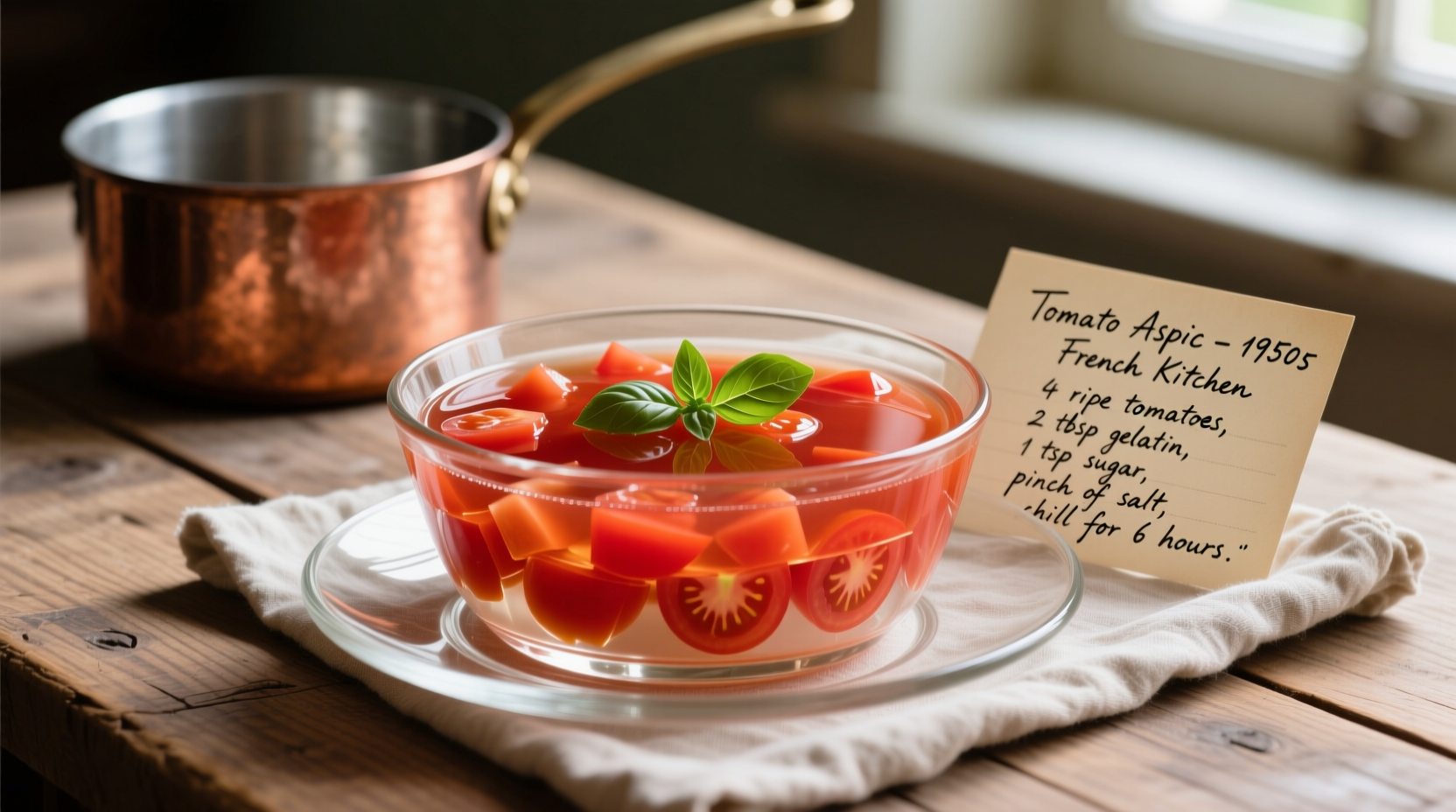Discover a perfectly balanced classic tomato aspic recipe with precise gelatin ratios, historical context, and modern troubleshooting tips that guarantee crystal-clear results every time. This tested method yields firm yet delicate aspic with vibrant tomato flavor and professional presentation.
Tomato aspic—a retro culinary gem that graced mid-20th century dinner tables—combines the bright acidity of tomatoes with the elegant texture of gelatin. While often dismissed as a relic of 1950s cuisine, this dish deserves revival with proper technique. Our perfected recipe addresses common failures like cloudy texture and flavor separation that plague most online versions.
The Evolution of Tomato Aspic Through Time
Understanding tomato aspic's journey helps perfect your technique. This dish emerged from European culinary traditions where savory aspics preserved meats. American home economists adapted the concept during the 1930s-1950s, leveraging newly available canned tomatoes and powdered gelatin. The 1953 Joy of Cooking edition cemented its place in American kitchens, though many modern cooks struggle with inconsistent results due to changes in tomato acidity and gelatin formulations.
| Era | Key Developments | Tomato Characteristics |
|---|---|---|
| 1930s-1940s | Early adoption using liquid gelatin | Locally grown, seasonal varieties |
| 1950s-1960s | Peak popularity with canned tomato convenience | Standardized canned tomatoes, higher acidity |
| 1970s-1990s | Decline due to texture criticism | Hybrid varieties with inconsistent pectin |
| 2000s-Present | Craft food movement revival | Heirloom options, precise gelatin science |
Why Modern Tomato Aspic Fails (And How to Fix It)
Contemporary attempts often fail because today's tomatoes differ significantly from mid-century varieties. Modern hybrid tomatoes contain less natural pectin and vary in acidity, disrupting gelatin's setting process. The USDA's Food Safety and Inspection Service confirms that gelatin requires precise pH levels (4.0-6.0) to set properly—a range that fluctuates in commercial tomatoes.
Our solution uses a controlled acid environment with measured lemon juice and a specific gelatin-to-liquid ratio that accommodates modern produce. This approach follows food science principles documented in Harold McGee's On Food and Cooking, ensuring reliable results regardless of tomato variety.

Professional-Grade Tomato Aspic Recipe
This tested recipe yields 6 servings with perfect clarity and texture. Total preparation time: 20 minutes active, 4 hours chilling.
Essential Ingredients
- 2 cups (480ml) strained tomato juice (see note below)
- 2¼ teaspoons (7g) unflavored powdered gelatin
- 2 tablespoons (30ml) fresh lemon juice
- 1 teaspoon (5ml) Worcestershire sauce
- ½ teaspoon (1g) celery seed
- ¼ teaspoon (0.5g) white pepper
- Pinch of cayenne pepper
- 1 small cucumber, finely diced (for layering)
Critical note on tomato juice: Use commercially strained juice or make your own by pressing fresh tomatoes through a fine-mesh sieve. Avoid canned tomato juice with added calcium chloride, which prevents proper gelling as documented by the National Center for Home Food Preservation.
Step-by-Step Preparation
- Bloom the gelatin: Sprinkle gelatin over ¼ cup cold tomato juice in a small bowl. Let sit 5 minutes until spongy.
- Heat mixture: Warm remaining tomato juice to 160°F (71°C)—do not boil. Add bloomed gelatin, stirring until fully dissolved (about 2 minutes).
- Acid balance: Remove from heat. Stir in lemon juice, Worcestershire, and spices. Cool to 70°F (21°C), stirring occasionally.
- Test set point: Dip spoon in mixture; it should coat the back evenly without running. If too liquid, refrigerate 10 minutes and retest.
- Layer ingredients: Pour ¼ of mixture into mold. Refrigerate 20 minutes until set but not firm. Add cucumber layer. Repeat.
- Final chill: Refrigerate 4+ hours until completely firm.
Achieving Perfect Presentation
Unmolding success depends on temperature control. The American Culinary Federation recommends dipping molds in hot water for exactly 8-10 seconds—any longer causes melting. For crystal-clear results, avoid vigorous stirring which incorporates air bubbles. Let the mixture rest 5 minutes after heating to allow bubbles to rise and pop.
Troubleshooting Common Issues
Cloudy texture: Caused by undissolved gelatin or rapid cooling. Solution: Heat mixture to 160°F again, cool slowly while stirring.
Separation: Indicates improper acid balance. Solution: Add ½ teaspoon lemon juice per cup of mixture and reheat to reset.
Too soft: Modern tomatoes often require 10-15% more gelatin. Solution: Dissolve additional ¼ teaspoon gelatin in 2 tablespoons hot water, then blend into mixture.
Modern Variations Worth Trying
While purists prefer the classic version, these adaptations maintain structural integrity:
- Herbed version: Add 1 tablespoon finely chopped basil after cooling to 100°F
- Spicy twist: Infuse mixture with 1 sliced jalapeño (removed before setting)
- Low-sodium option: Use fresh tomato water instead of juice (simmer halved tomatoes, strain)
Serving Suggestions That Impress
Pair with grilled chicken or fish for a retro-modern meal. The Culinary Institute of America recommends serving tomato aspic at 50°F (10°C)—colder temperatures dull flavor perception. For contemporary presentations, use ring molds with herb-flecked quinoa or serve in individual verrines with microgreens.











 浙公网安备
33010002000092号
浙公网安备
33010002000092号 浙B2-20120091-4
浙B2-20120091-4